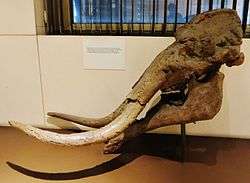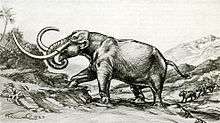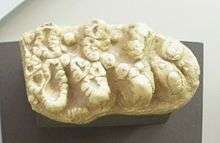Choerolophodon
Choerolophodon is an extinct genus of proboscid which lived during the Miocene of Eurasia and Africa.
| Choerolophodon | |
|---|---|
 | |
| Skull | |
| Scientific classification | |
| Kingdom: | |
| Phylum: | |
| Class: | |
| Order: | |
| Family: | |
| Genus: | †Choerolophodon Schlesinger, 1917 |
| Species | |
| |
| Synonyms | |
| |
Taxonomy

Restoration
Numerous species of Choerolophodon are known: C. pentelicus, C. anatolicus and C. chioticus from SE Europe (Turkey (Yamula Dam in Kayseri), Greece, Bulgaria) and the Middle East, C. palaeindicus and C. corrugatus from the Indian subcontinent, C. guangheensis from China, and C. ngorora and C. zaltaniensis from Africa.[1] The name Choerolophodon was erected for "Mastodon" pentelicus from Greece by Schlesinger (1917) based on the discovery of new material from the pentelicus type locality.[2]
Distribution

Molar
Fossils of Choerolophodon have been found in Africa, SE Europe, Turkey, Iraq, Iran, the Indian subcontinent, and China.[3][4][5][6]
gollark: Is there no end to the madness?
gollark: Iota... calculus?
gollark: They have infested even combinator definitions!
gollark: EVIL BRACKETS!
gollark: Just drop broken ones and mutate differently.
References
- George E. Konidaris, George D. Koufos, Dimitris S. Kostopoulos & Gildas Merceron (2016) Taxonomy, biostratigraphy and palaeoecology of Choerolophodon (Proboscidea, Mammalia) in the Miocene of SE Europe-SW Asia: implications for phylogeny and biogeography, Journal of Systematic Palaeontology, 14:1, 1-27, DOI: 10.1080/14772019.2014.985339
- Schlesinger, G., 1917. Die Mastodonten des K. K. Naturhistorischen Hofmuseums. Denkschriften des K. K. Naturhistorischen Hofmuseums 1:1-230.
- Chunxiao Li, Shi-Qi Wang, Dimila Mothé & Xijun Ni (2019) New fossils of early and middle Miocene Choerolophodon from northern China reveal a Holarctic distribution of Choerolophodontidae, Journal of Vertebrate Paleontology, DOI: 10.1080/02724634.2019.1618864
- Sankhyan, Anek R. and Chavasseau, Olivier. 2018. New proboscidean fossils from Middle Siwaliks of Haritalyangar area, Himachal Pradesh, India. Palaeontologia Electronica 21.1.15A 1-12. https://doi.org/10.26879/844 palaeo-electronica.org/content/2018/2200-haritalyangar-proboscideans
- Wang, S.; Deng, T. (2011). "The first Choerolophodon (Proboscidea, Gomphotheriidae) skull from China". Science China Earth Sciences. 54 (9): 1326. doi:10.1007/s11430-011-4201-6.
- "Tek parça halinde ve 7.5 milyon yıllık! Kayseri'de bulundu - Habertürk". Haberturk.com (in Turkish). Habertürk. 28 August 2019. Retrieved 9 September 2019.
This article is issued from Wikipedia. The text is licensed under Creative Commons - Attribution - Sharealike. Additional terms may apply for the media files.